Family : Muscicapidae

Text © Dr. Andrea Giordano

English translation by Mario Beltramini
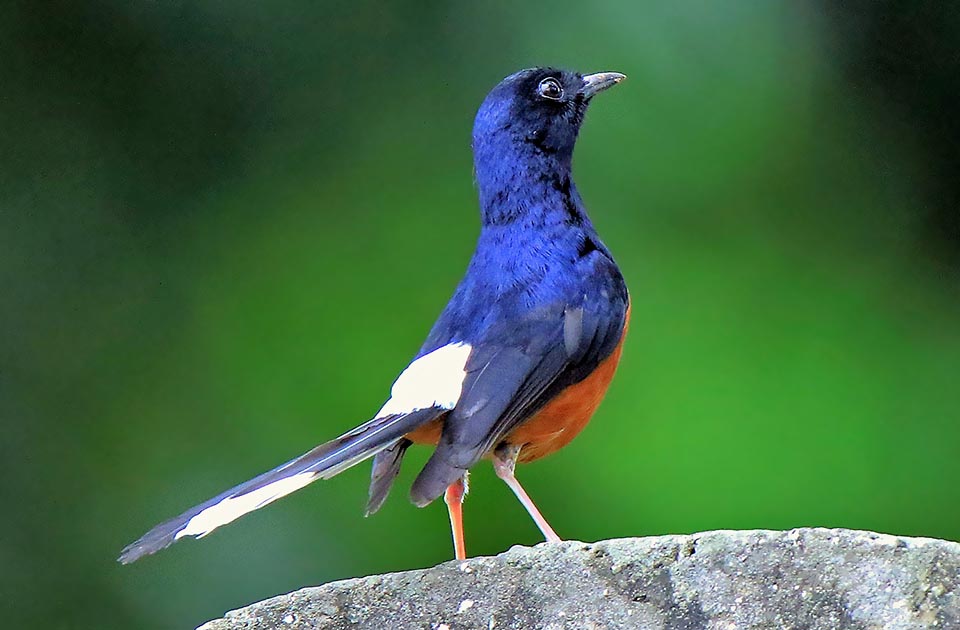
The White-rumped shama (Copsychus malabaricus) so called for the white back plumage visible in both sexes between tail and wings, is one of the most sought after birds by breeders due to its livery beauty and the extraordinary singing capacities. It’s an insectivore of the Indian subcontinent, South-East Asia and South China © Khoi Tranduc
The White-rumped shama (Copsychus malabaricus (Scopoli, 1786-1788)) is one of the most loved exotic birds because of the beauty of its plumage as well as for its extraordinary singing skills, and is not surprising the fact that it is one of the most sought-after birds by the breeders.
The term “shama” is of uncertain etymology, but, most probably, gets its origin from the Hindi name (शामा), utilized when referring to this species even if the scholars tend to use it to indicate also other members of the genus Copsychus, i.e. Rufous-tailed shama, (Copsychus pyrropygus), White-crowned shama, (C. stricklandii), White-browed shama, (C. luzoniensis) and, at times, the entire species.
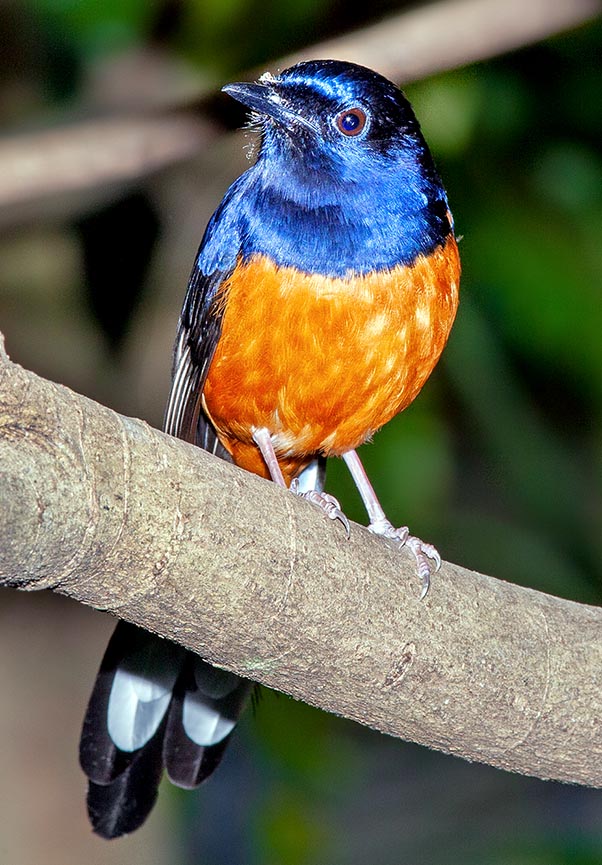
Apart colours and tail, also for the common love for melodious singing, could be almost said a Blackbird (Turdus merula), as anyway suggests the scientific name, in fact once was classified among the Turdids, but now has been more properly assigned to the flycatchers family, the Muscicapidae © Giuseppe Mazza
The White-rumped shama belongs to the most numerous orders of birds, that of the passerines, and to the family of the “Old World flycatchers” or, more correctly, the muscicapids (Muscicapidae). It is not a case that the family name originates from the Latin words “musca” (fly) and “capere” (to catch).
Conversely, Copsychus, the name of the genus to which it belongs, gets its origin from “kópsikhos” (κόψιχος) that in Old Greek means “blackbird”, whilst malabaricus comes from the Malabar, geographic area of south-western India mainly extending in the modern Kerala and Karnataka.
Therefore, the meaning of the scientific name of this species is “Malabar blackbird”. It was not by chance that in the past it was believed that the White-rumped shama belonged to the turdids, (Turdidae) like the Blackbird (Turdus merula), to which it has been associated because of the common black plumage, even if that of the Shama has more bluish shades and propensity for melodic singing.
Zoogeography
This passerine is distributed along the Indian subcontinent, South-East Asia, and southern China, unofficially classified by the IUCN as a species at minimum risk. However, its status varies in a considerable manner depending on the geographical area being analyzed, mainly due to the destruction of its habitat and to the commercial traffics that involve it, as a pet as well as a singing competition animal. These phenomena in some countries lead it to be at risk of extinction.
The selective destruction of forests such as those occurring in Borneo forms one of the elements of major worry: the formation of cleared areas leads to micro-climatic changes, to the decrease of the insects it eats, of nesting places and of the materials necessary to build the nest, like an increase in the rate of predation on the kids and of the eggs, always more impacting.
In countries like Singapore, Malaysia, Indonesia, Brunei and Thailand, the poaching gives no respite to the White-rumped shama, whose sedentary and territorial habits facilitate its location and capture: it is often considered as the best singing bird, especially along the Malay peninsula and Singapore, that, united with the beauty of the plumage leads the buyers to be willing to pay even remarkably high amounts of money for having it.
The figures in question are rather variable and concern mainly the males, as they display the most beautiful plumages and songs.
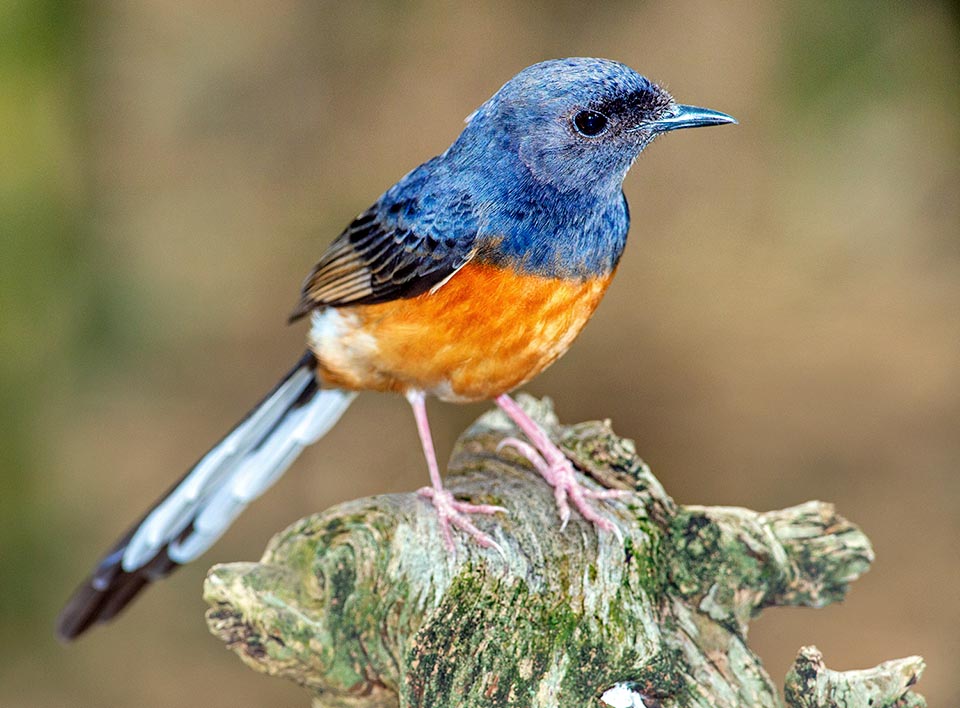
It eats insects like ants, cockroaches, grasshopper, caterpillars and worms, and also earthworms and spiders, plus some berries © Giuseppe Mazza
The singing fame of the White-rumped shama is such as to have made it one of the first birds in history whose song has been recorded, precisely by Ludwig Koch in 1889. It is especially thanks to the singing competitions, very popular in south-eastern Asia, that these animals may reach dizzying economic values: one single male, if considered valuable, may get values exceeding thousands of Euros.
The participation to the competitions, and even more their victory, allow to increase the cost of sale of the specimen in a considerable manner, especially is we consider the presence of spectators and of buyers from all economic groups: this fact is very attractive, especially in countries where poverty and misery are greater, and for this reason the resulting business avers particularly strong and worrying, placing at serious risk also many other species of birds.
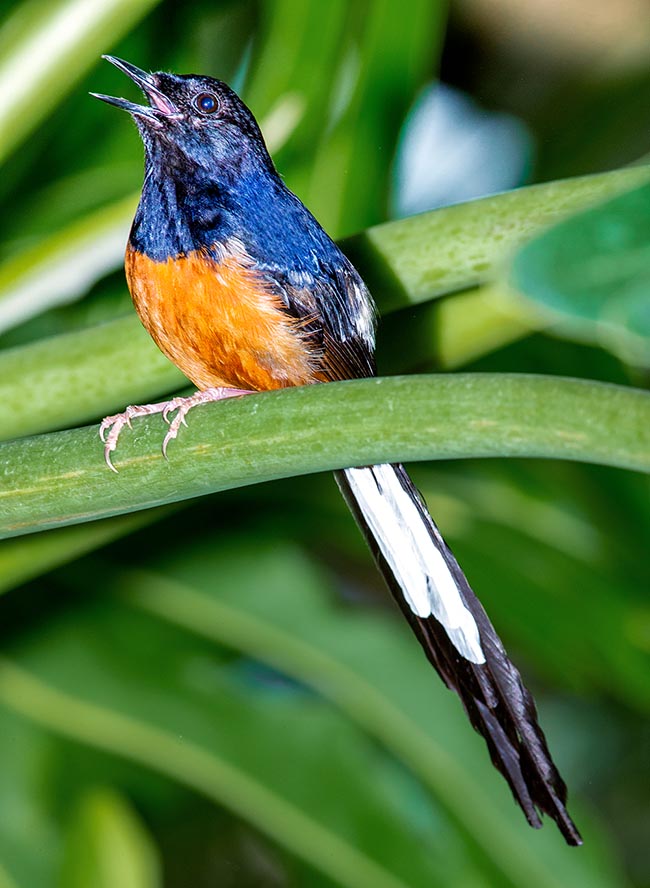
Singing is its strong point, ensign of marked territoriality with which the males control about 1.000 square metres © Giuseppe Mazza
A unique criterion for declaring the winners does not exist: depending on the competition, the birds are judged on the tone, on the variety of notes, on the elegance displayed while singing, on the length of the notes, or also on the capacity of the specimens in imitating the other birds songs.
With these competitions are also connected cash prizes and sale of accessories and at times they even become a real form of tourist attraction hard to hinder. As if that were not enough, many manifestations of this kind are managed by organized racketeers.
The popularity of the White-rumped shama has led it to be also introduced in new geographical areas, where at times reveals to be an invasive species especially for insects and other species of birds (well-known are its introductions in the Hawaii Islands, Hong Kong and Taiwan).
Unlike other allochthonous species tending to prefer the anthropic areas, the “Malabar blackbird” loves the natural ones, thus entering greatly in competition with the local species because of its extreme territoriality.
Ecology-Habitat
The White-rumped shama mainly populates the humid areas interested by a dense vegetative coverage, like woody or forest areas, including the forests of bamboo and of secondary jungle.
The colouration of its plumage facilitates its concealment from predators, also thanks to its tendency to nourish during the twilight hours. The diet of the White-rumped shama is mainly formed by insects such as ants, cockroaches, grasshoppers and caterpillars, but also by spiders, centipedes, earthworms and some berries.
Usually, the animal tends to explore the soil and the bushes looking for food by means of small and rapid sprints and hops.
Apart from the twilight hours, the White-rumped shama hardly spends long time on the soil, preferring to perch on the trees and move in flight. Due to all this series of reasons, it is overall a difficult animal to spot, even if its territorial habits lead it usually not to move in a significant way; in fact, during its monitoring, it is often more effective to rely on its vocalizations, even if it is important to keep in mind its capacity of imitating the songs of other birds.
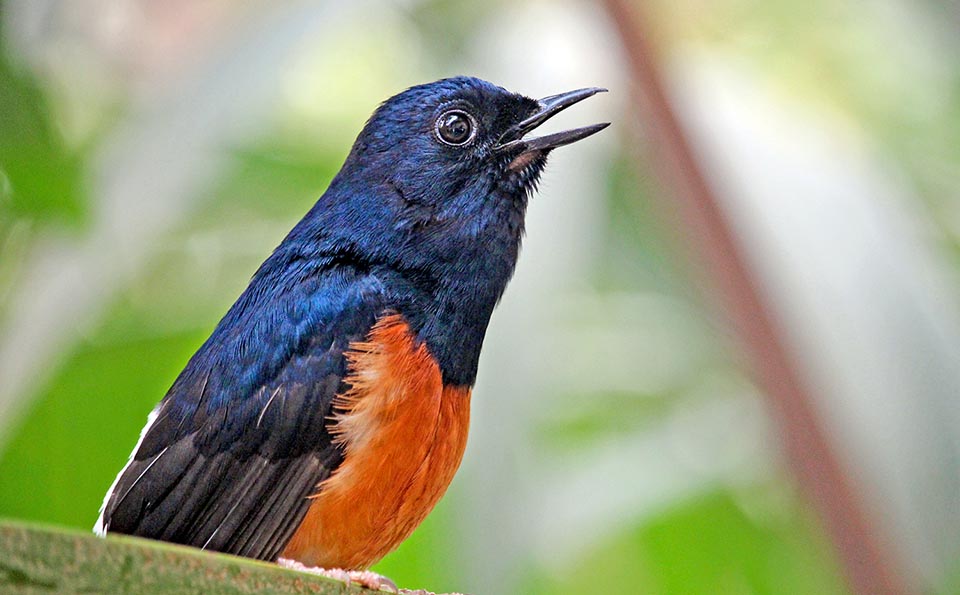
Unluckily this virtuosity has meant it even the life imprisonment in narrow cages, tossed in singing competitions where the winners are often sold at astronomical prices © Laura Barroso
The home range of the White-rumped shama is usually of about 0,1 ha (about 1.000 square metres). The single individual defends its own territory, but when the couple forms, it is the male to mainly take care of it. The species tends to be monogamous, but it is possible that outside the reproductive period, the male and the female distribute in different territories.
Usually, the White-rumped shama keeps at altitudes not exceeding the 600 m above the sea level, but in Thailand it may even go up to 1.500 m. Like many other species, it frequents ponds and streams for drinking and for cleaning carefully its plumage, from which depend the reproductive success and the flight efficiency.
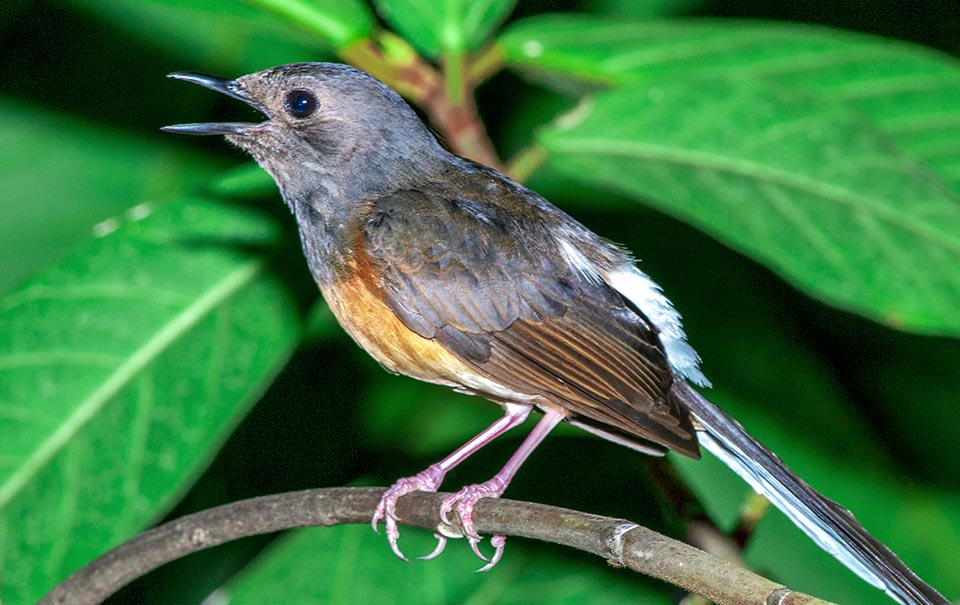
The females that don’t have the blue shades and the males size, content with shorter songs, and the brief contact signal typical to the species © Giuseppe Mazza
It also frequents anthropic environments, such as parks, gardens and plantations. It may be sighted even in the parks of big cities like Bangkok, Singapore and Taipei.
Morphophysiology
In this species we appreciate the sexual dimorphism, at level of the plumage as well as of the dimensions. In both sexes we can distinguish two main liveries, an upper one, located between the chest, including the wings, and the extremity of the tail, interrupted only by the renowned white rump, and a lower one, in both of reddish colour and placed between the chest and the chinstrap.
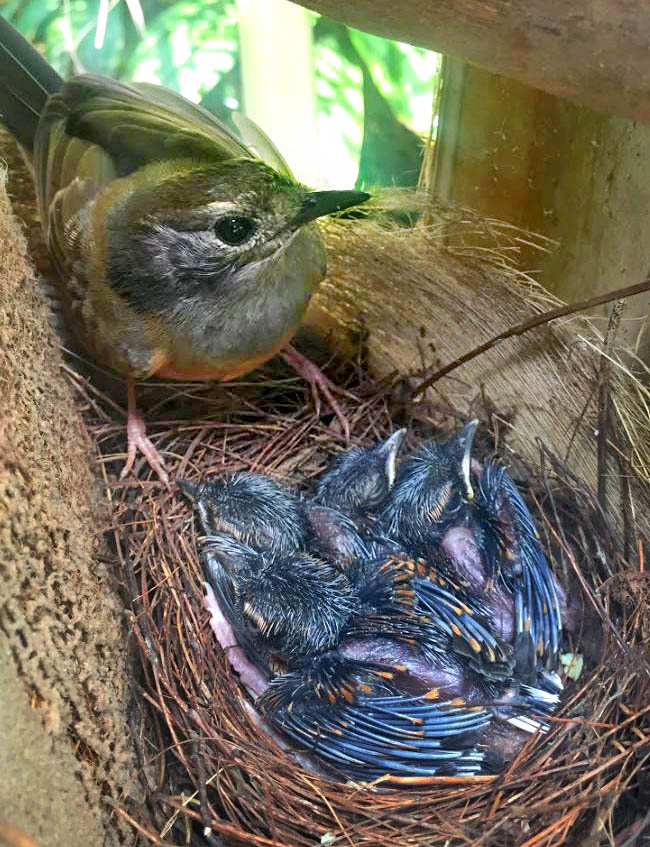
A rare image of the nest, built by the female, that hatches 3-4 eggs for 12-15 days © Dylan James
In the male the upper livery is of black-bluish colour, that, when contrasting the sun’s rays, creates almost metallic reflections thanks to the prismatic structure of the feathers forming it.
Conversely, in the female it is grey-brownish and its plumage tends to present in its whole more opaque tonalities, including the reddish colour of the lower livery.
The plumage of the young is quite like the adult females’ one, but the reddish livery usually displays darker tonalities in the chest region.
To distinguish the young from the adult females cannot be always easy, depending on the age of the individuals: it is therefore important to rely also on the dimensions, where the young are smaller and have shorter tails.
Moreover, in both sexes we note black bills and eyes, pink legs and outer feathers placed in the lower part of the tail of white colour with black or greyish base depending on the sex.
These feathers create a neat contrast with the dark background of the tail and allow these animals to be able to perform rapid changes of direction during the flight.
Instead, the inner surface of the wings is greyish, with a branch of reddish colour along the minor coverts and the alula depending on the individuals.
It is important to keep in mind that the White-rumped shama presents a high number of subspecies and consequently the morphological characteristics just described are to be considered as of general nature.
The subspecies generally taken as a model is the nominal one, the Copsychus malabaricus malabaricus; the number of the subspecies varies in a sensitive way after the scholars, but most of them tend to recognize fifteen to twenty of them.
The most heated debates originate from the presence of some subspecies that usually are recognized as species themselves. Among these, are noteworthy the Andaman shama (Copsychus albiventris) and the White-crowned shama (C. stricklandii, including two subspecies that are sometimes considered as subspecies of the White-rumped shama). The morphology is practically the same, but in the Andaman shama we appreciate in the lower portion of the plumage a more or less extended white colouration; usually the reddish livery is confined between the joint of the legs and the undertail. The White-coloured shams, instead, presents on the top of the head a white spot that leads it to be known in English as “White-crowned shama” (literally, “Crowned of white Shama”).
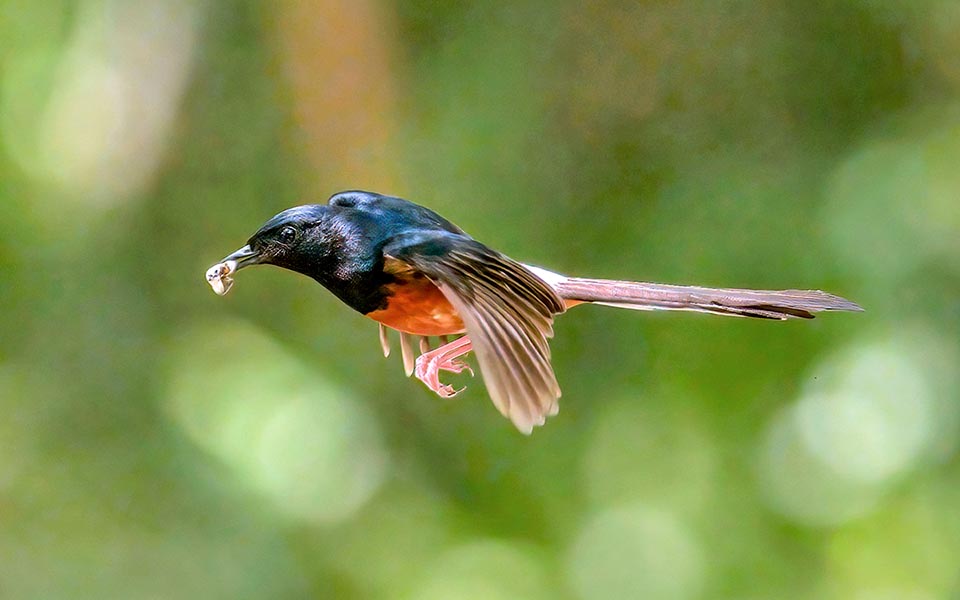
The male cares the control of the territory and of the family sustenance, nourishing the hatching partner and then the kids © Yu-Chieh Chen
For what concerns the dimensions, in the White-rumped shama the male is bigger than the female: the male can reach the length of 28 cm, with 18 cm of length of the tail, whilst the female usually reaches the 22-23 cm, with a width of the tail of 14-15 cm. The males are also heavier, as they can reach the 35 g, whilst the weight of the females is usually about 18 g.
Ethology-Reproductive Biology
As we have been able to realize on more than one occasion, talking of the White-rumped shama is equivalent to be talking of a great songwriter: the song, the melodies and the tracks are omnipresent, covering always a central role in its existence.
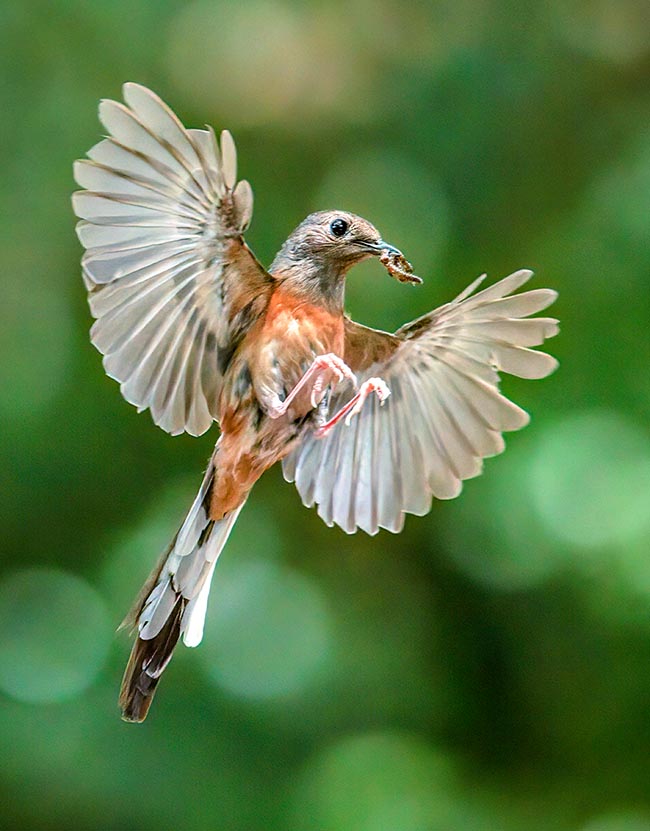
When growing, the demand of food increases and so also the female goes hunting © Yu-Chieh Chen
Its texts are complex, rich in different notes and tones, melodies, strong and at times even delicate, with elements expressly chosen for the partner. In fact, the White-rumped shama is a songwriter in the proper sense of the term, with texts varying that depend on the individual composing them.
The complexity of their songs reaches the maximum levels thanks to the integration of melodies of other birds, that may even favour the creation of new melodies and the fusion of the same, in a way similar to the most known Superb lyrebird (Menura novaehollandiae).
The males emit the most beautiful and complex melodies, but also those with higher tones: the reasons are linked to the use of the song as main instrument of seduction of the females and of defense of the territory, that as we know, at the time of the formation of the couple, is mainly competence of the male.
The vocalizations of the male are strong enough that they can be heard at various undred of metres far away, an extraordinary fact to say the least especially if we consider the small size of these animals.
The females emit shorter songs and especially during the mating season or, anyway, in presence of the partner.
The males as well as the females often resort to the use of squeaky “tschak” and “tek” to indicate their presence, but also while foraging or when alarmed by disturbing factors.
The reproductive season of the White-rumped shama tends to place itself between March and June. During the courting, the male performs its own parade with the female observing it usually from below: the male ensures to look at her always attracting its attention with acute and melodious calls accompanied by fast head swings up and down and as many oscillations and openings of the caudal feathers.
Then both sexes begin to effect continuous and short up and down vaultings, while the frequency of movement of the caudal feathers of the male increases. If the female is not interested in mating, it pushes the male away keeping the bill open. Conversely, if the female responds to its calls, that is a very encouraging signal; also after the formation of the couple, male and female tend to call each other constantly.
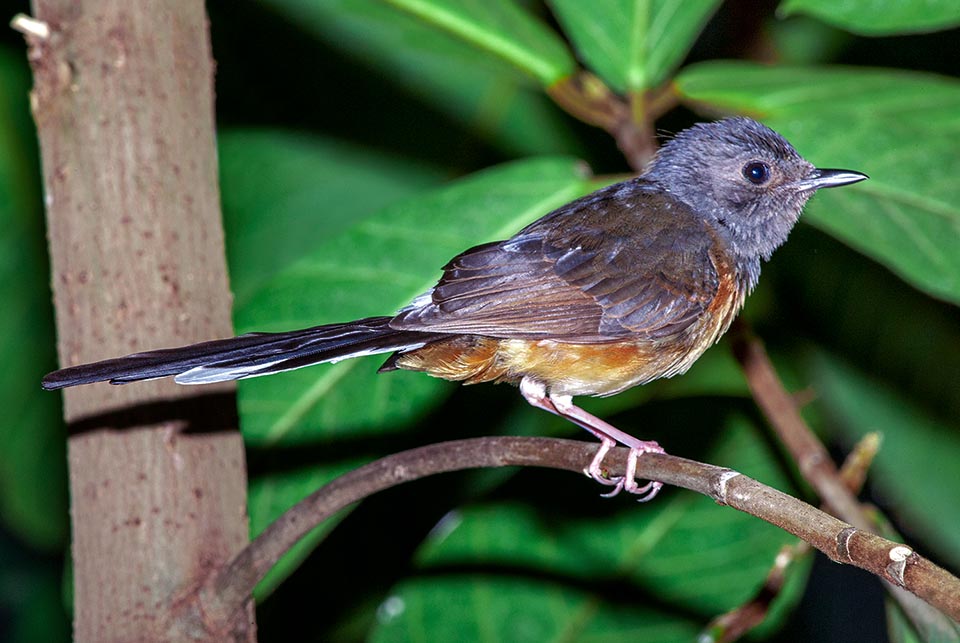
A young. Initially the livery is very similar to the female’s one and in nature the life expectancy is of about 7 years © Giuseppe Mazza
Usually, the nest is built by the female with roots, stems and leaves around March, whilst the male is in charge of the custody of the territory. The same hatching is carried on by the female inside cavities in the trees or in the undergrowth, laying three to four eggs; these are small, indicatively of about 20 mm and their colouration varies from white to pale green with several brown reddish dots. The incubation lasts 12 to 15 days and at the time of the birth the newborns are blind and featherless.
The eyesight comes around the sixth day of life and after only 11 days the nestlings develop already a total coverage of the body. Both parents are occupied with the care and the feeding of the progeny.
Synonyms
Kittacincla malabarica (Scopoli, 1786); Kittacincla macrura (J. F. Gmelin, 1789).
→ To appreciate the biodiversity within PASSERIFORMES please click here.
